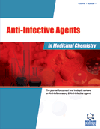- Home
- A-Z Publications
- Anti-Infective Agents in Medicinal Chemistry (Formerly Current Medicinal Chemistry - Anti-Infective Agents)
- Previous Issues
- Volume 6, Issue 2, 2007
Anti-Infective Agents in Medicinal Chemistry (Formerly Current Medicinal Chemistry - Anti-Infective Agents) - Volume 6, Issue 2, 2007
Volume 6, Issue 2, 2007
-
-
Burkholderia pseudomallei - Antimicrobial Susceptibility Testing and Alternative Models of Predicting Clinical Efficacy.
More LessMelioidosis is caused by the gram-negative bacterium Burkholderia pseudomallei. The disease can present with a diverse range of clinical manifestations and is endemic in northern Australia and Southeast Asia. There is a dramatic increase in clinical cases during the wet season and mortality rates remain as high as 70% in some endemic areas. This is despite current optimal treatment with ceftazidime or meropene Read More
-
-
-
Mass Spectrometry, Proteomics, Data Mining Strategies and Their Applications in Infectious Disease Research.
More LessAuthors: Andreas Evangelou, Limor Gortzak-Uzan, Igor Jurisica and Thomas KislingerThe ultimate goal of proteome research is the comprehensive description of all proteins present in a given sample using qualitative, quantitative and functional metrics. Traditionally, protein mixtures were first separated by twodimensional gel electrophoresis and spots of interest were excised, in-gel digested and analyzed by mass spectrometry (MS). In most cases, protein identification was done by MALDI-TOF-MS (mat Read More
-
-
-
Aminoglycosidic Aminocyclitol Antibiotics-A Wonder, But Toxic Drugs:Developments and Clinical Implications
More LessBy M. ShahidAminoglycosides are aminoglycosidic aminocyclitols that contain amino sugars linked to an aminocyclitol ring by glycosidic bonds. Although relatively toxic compared with other classes of antibiotics, they remain primarily useful drugs in the treatment of infections caused by gram-negative bacteria. Since the advent of streptomycin by Waksman and co-workers, a series of milestone compounds like kanamycin, gent Read More
-
-
-
Inactivation of Pathogenic Microorganisms by Photodynamic Techniques:Mechanistic Aspects and Perspective Applications.
More LessAuthors: Giulio Jori and Olimpia CoppellottiThe worldwide rise in antibiotic resistance by microorganisms has stimulated intensive research toward the development of alternative therapeutic strategies. Photodynamic therapy (PDT) is emerging as a promising modality for the treatment of localized microbial infections. Studies on the relationship between the chemical structure of photosensitising agents and their phototoxicity against microbial pathogens led to the ide Read More
-
-
-
Medicinal Use of Lincosamides and Microbial Resistance to Them
More LessAuthors: Tomas Rezanka, Jaroslav Spizek and Karel SiglerLincomycin and its derivatives are antibiotics exhibiting biological activity against bacteria, especially Grampositive ones, and also protozoans. Lincomycin and its semi-synthetic chlorinated derivative clindamycin are widely used in clinical practice. Both antibiotics are bacteriostatic, inhibiting protein synthesis in sensitive bacteria, and they may even be bactericidal at higher concentrations that can still be reached in Read More
-
-
-
Revitalized Strategies Against Multi-Resistant Bacteria: Antimicrobial Photodynamic Therapy and Bacteriophage Therapy
More LessBy Tim MaischThe formation and spread of infections by multi-resistant bacteria is favoured by the absence of hygienic measures to prevent the spread in hospital settings as well as the frequent use of antibiotics. Overall, approximately 20% of Staphylococcus aureus isolates in Europe are reported as methicillin resistant and cause serious nosocomial infections. Therefore, the worldwide rise in antibiotic resistance in clinical practise has Read More
-
Most Read This Month
Article
content/journals/aiamc
Journal
10
5
false
en


